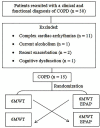Influence of expiratory positive airway pressure on cardiac autonomic modulation at rest and in submaximal exercise in COPD patients
- PMID: 29694504
- PMCID: PMC5937727
- DOI: 10.1590/1414-431x20187180
Influence of expiratory positive airway pressure on cardiac autonomic modulation at rest and in submaximal exercise in COPD patients
Abstract
The aim of this study was to evaluate the effect of expiratory positive airway pressure (EPAP) on heart rate variability (HRV) indices at rest and during 6-min walk test (6MWT) in chronic obstructive pulmonary disease (COPD) patients. Fifteen moderate to severe COPD patients were randomized and evaluated with and without (Non-EPAP) a 5 cmH2O EPAP device. Respiratory rate (RR) was collected at rest (5 min), during the 6MWT (5 min), and at recovery (5 min). Indices of HRV were computed in the time domain, in the frequency domain, and nonlinear analysis. For EPAP and Non-EPAP during the 6MWT, we found an increased mean heart rate (HR) (P=0.001; P=0.001) while mean RR (P=0.001; P=0.015) and RR tri index decreased (P=0.006; P=0.028). Peripheral oxygen saturation (P=0.019) increased at rest only in the EPAP group. In EPAP, correlations were found between forced expiratory volume in 1 s (FEV1) and low frequency (LF) sympathetic tonus (P=0.05; r=-0.49), FEV1 and high frequency (HF) parasympathetic tonus at rest (P=0.05; r=0.49), lactate at rest and LF during the 6MWT (P=0.02; r=-0.57), and lactate at rest and HF during 6MWT (P=0.02; r=0.56). Through a linear regression model, we found that lactate at rest explained 27% of the alterations of LF during 6MWT. The use of 5 cmH2O EPAP improved autonomic cardiac modulation and its complexity at rest in COPD patients. Although it did not influence the performance of the 6MWT, the EPAP device caused alterations in resting lactate concentration with an effect on sympatho-vagal control during the test.
Figures




Similar articles
-
Is cardiac autonomic modulation during upper limb isometric contraction and Valsalva maneuver impaired in COPD patients?Int J Chron Obstruct Pulmon Dis. 2017 Mar 13;12:849-857. doi: 10.2147/COPD.S130428. eCollection 2017. Int J Chron Obstruct Pulmon Dis. 2017. PMID: 28331306 Free PMC article. Clinical Trial.
-
Complexity analysis of heart rate variability in chronic obstructive pulmonary disease: relationship with severity and symptoms.Clin Auton Res. 2020 Apr;30(2):157-164. doi: 10.1007/s10286-019-00659-z. Epub 2020 Jan 14. Clin Auton Res. 2020. PMID: 31938978
-
Aerobic exercise training improves autonomic nervous control in patients with COPD.Respir Med. 2009 Oct;103(10):1503-10. doi: 10.1016/j.rmed.2009.04.015. Epub 2009 May 22. Respir Med. 2009. PMID: 19464865 Clinical Trial.
-
Heart rate variability and autonomic activity at rest and during exercise in various physiological conditions.Eur J Appl Physiol. 2003 Oct;90(3-4):317-25. doi: 10.1007/s00421-003-0953-9. Epub 2003 Sep 12. Eur J Appl Physiol. 2003. PMID: 13680241 Review.
-
Effects of exercise on heart rate variability: inferences from meta-analysis.Med Sci Sports Exerc. 2005 Mar;37(3):433-9. doi: 10.1249/01.mss.0000155388.39002.9d. Med Sci Sports Exerc. 2005. PMID: 15741842 Review.
Cited by
-
Use of the six-minute walk test in exercise prescription in male patients after coronary artery bypass surgery.Kardiochir Torakochirurgia Pol. 2020 Dec;17(4):183-188. doi: 10.5114/kitp.2020.102340. Epub 2021 Jan 15. Kardiochir Torakochirurgia Pol. 2020. PMID: 33552181 Free PMC article.
References
-
- Reis MS, Sampaio LM, Lacerda D, De Oliveira LV, Pereira GB, Pantoni CB, et al. Acute effects of different levels of continuous positive airway pressure on cardiac autonomic modulation in chronic heart failure and chronic obstructive pulmonary disease. Arch Med Sci. 2010;6:719–727. doi: 10.5114/aoms.2010.17087. - DOI - PMC - PubMed
Publication types
MeSH terms
Substances
LinkOut - more resources
Full Text Sources
Other Literature Sources
Medical
Research Materials
Miscellaneous

